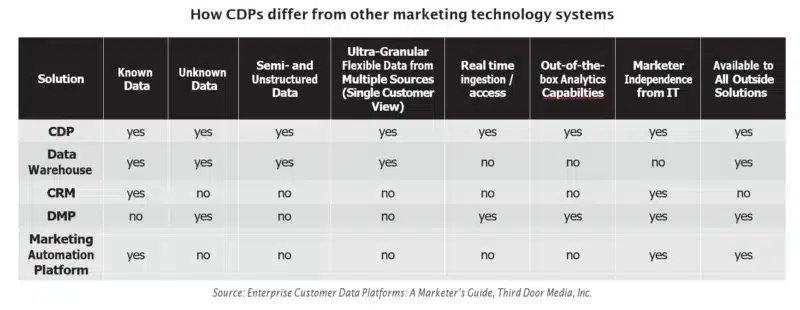Customer data platforms give marketers control over data collection, segmentation, and orchestration through out-of-the-box integrations that rarely require IT or developer involvement.
Customer data platforms (CDP) are marketer-managed systems designed to collect customer data from all sources, normalize it, and build unique, unified profiles for each customer. The result is a persistent, unified customer database that shares data with other marketing technology systems.
Marketer interest in CDPs increased significantly — by 32% — between 2021 and 2022, according to Gartner. Interest in the category among CIOs, which may represent the involvement of these technology leaders in buying committees, rose by 91% between 2020 and 2021.
One factor driving this trend is the increasing importance of customer experience, which is improved through timely data gathering, AI-assisted segmentation, and the personalization of interactions. At the same time, marketers face the gradual but seemingly inevitable extinction of third-party data as fuel for their marketing programs. Therefore, businesses are looking to CDPs to bolster their first-party data and engage in privacy-compliant practices like sharing through data clean rooms.
CDPs enable marketers to create a single view of the customer by gathering data from software deployed throughout the organization. High expectations, along with the proliferation of possible customer touchpoints, make cross-device IDs and identity resolution — the ability to consolidate and normalize disparate sets of data collected across multiple touchpoints into an individual profile that represents the customer or prospect — critical for helping marketers, sales and service professionals deliver the ideal total customer experience. CDPs offer this consolidation and normalization and also make the data profiles freely available to other systems that deliver campaigns, webpages and other interactions.
Table of contents
- What is a customer data platform (CDP)?
- Different types of CDP
- Customer data management
- Analytics
- Orchestration
- Data regulation compliance
- Third-party systems integration
- What are the benefits of using a CDP?
What is a customer data platform (CDP)?
A CDP provides three core features that make it unique from other systems.
- A unified, persistent customer database that provides data transparency and granularity at the known individual level. A CDP can identify customers from many different data sources by stitching together information under a unique identifier. The CDP then stores a copy of the data.
- Control over customer data collection, segmentation, and orchestration through native (out-of-the-box) integration that minimizes the need for IT or developer involvement.
- Data integration of known and anonymous customer data with any external source or platform, including CRM, point of sale (POS), mobile, transactional, website, email, and marketing automation.
CDPs can be used as systems of record, storing known and unknown customer profiles in a central repository that integrates data from the organization’s software and operational systems. The data is accessible for marketing analysis, segmentation, and insight discovery to increase the velocity and effectiveness of omnichannel marketing campaigns.
A CDP is not a CRM, DMP, or marketing automation platform. A CDP provides a unified, persistent customer database that provides data transparency and granularity at the known individual level. A CDP can identify customers from many different data sources by stitching together information under a unique identifier. The CDP then stores a copy of the data.

CDPs also give marketers control over customer data collection, segmentation, and orchestration through native (out-of-the-box) integration that minimizes the need for IT or developer involvement. Lastly, CDPs offer data integration of known and anonymous customer data with any external source or platform, including CRM, point of sale (POS), mobile, transactional, website, email, and marketing automation.
Also Read: Understanding Composable Tech Stack
The CDP Institute’s definition of a “RealCDP” requires it be able to do the following five things:
- Ingest real-time data from any source.
- Capture full details of ingested data.
- Store ingested data indefinitely (subject to privacy constraints).
- Create unified profiles of identified individuals.
- Share data with any system that needs it.
Virtually all of the CDP vendors that meet that criteria provide the following core capabilities:
- Data management (collect, normalize, and unify customer data in a persistent database),
often after other systems have matched IDs. - Features designed for use by the marketing organization and other departments, without IT or data science resources. (Some functions, like building connections to other
platforms and performing sophisticated data modeling, still require additional resources.) - Connections to and from all external systems on a vendor-neutral basis.
- Structured and unstructured data management.
- Online and offline data management.
CDP vendors differentiate by offering more advanced capabilities that include, but are not limited to, the following:
- Native identity resolution to stitch customer data snippets from disparate sources.
- The number and breadth of robust pre-built connectors to other martech systems. The near-universal availability of APIs means connections are always possible (with more or less developer involvement), but offering pre-built, tested integrations adds value.
- User interface (UI). The vendors differ in the user-friendliness of their interfaces and the methods people use to create segments, view profiles, etc.
- Analytics, including those powered by machine learning and artificial intelligence, that surface insights enable journey mapping, audience segmentation, and predictive modeling.
- Orchestration for personalized messaging, dynamic interactions, and product/content recommendations.
- Compliance with vertical industry and international data regulations.
Different types of CDP
Though CDPs share a category name, systems differ substantially in their primary focus. Because of this, the CDP Institute has divided the market by “types” of CDPs — data, analytics, campaign, and delivery.
These specializations are a legacy of CDP vendors’ origins in other spaces. For example, some Data CDPs began as tag management or web analytics providers, leveraging the data they gathered to expand into linking data to customer identities, assembling unified customer profiles, and storing them. While these systems allow users to extract audience segments and send them to external systems, Analytics CDPs do all this and more. Their capabilities include machine learning, predictive modeling, revenue attribution, and journey mapping.
Campaign CDPs, according to the CDP Institute, “provide data assembly, analytics, and customer treatments,” which are closer to one-to-one addressability than segments. They also offer features to orchestrate campaigns across channels. Similarly, Delivery CDPs focus on delivering profiles and messages through email, websites, mobile apps, CRMs, and more. These players sometimes began as systems to deliver messaging, later adding CDP features.
It’s worth noting that a new type of CDP is emerging, which lets marketers “compose” a CDP to suit their needs by yoking together software from different companies or assembling modules from the same vendor. It’s similar to what some advocate for in digital experience platforms (DXPs), where a business can be more agile by picking and choosing modules with different functionalities (and swapping them out as needed).
Customer data management
Real-time data collection and maintenance is a core CDP customer data management platform function. All CDPs provide a central database that collects and integrates personally identifiable customer data across the enterprise. From there, however, CDPs vary in their abilities to manage the following:
- Data ingestion capabilities: CDPs use various mechanisms to ingest the data that goes into the unified customer profile — mobile SDKs, APIs, Webhooks, or built-in connectors to other platforms. Identity resolution: The platform “stitches” together customer data points, such as email addresses, phone numbers, first-party cookies, and purchase data, from various channels, matching them to create a single customer profile.
- Identity resolution: The platform “stitches” together customer data points, such as email addresses, phone numbers, first-party cookies, and purchase data, from various channels, matching them to create a single customer profile. Some players partner with other providers for this capability, while others have their systems.
- Online/offline data: The platform leverages identity resolution or an identity graph to stitch together behaviors to create a unified profile.
- Data hygiene: The platform enables users to clean and standardize customer records.
Structured/unstructured data: CDPs differ in their capabilities to manage unstructured data (i.e., social media feeds, product photos, and barcodes), which may comprise up to 80% of all data by 2025, according to IDG.
The importance of these data management capabilities will depend on a particular organization’s business goals and whether it has a significant mobile presence, direct mail budget, or brick-and-mortar stores and agents.
Also Read: Brand Profile: Buffer – From Startup Rollercoaster to Social Media Leader
Analytics
CDP vendors offer analytics capabilities that can do some or all of these: allow marketing end-users to define and create customer segments, track customers across channels, and glean insights into customer interest and intent from customer behavior and trends.
The functionality can include predictive models, revenue attribution, and journey mapping. To one extent or another, many of these capabilities may utilize machine learning or artificial intelligence to surface insights about audiences and proactively offer suggestions about the best next step to move a prospect through their purchase journey.
Orchestration
A select group of CDPs provides campaign management and customer journey orchestration features that enable personalized messaging, dynamic web and email content recommendations, and campaigns that trigger targeted ads across multiple channels.
The customer data platform often automates the distribution of marketer-created customer segments on a user-defined schedule to external martech systems such as marketing automation platforms, email service providers (ESPs), or web content management systems for campaign execution.
For example, the CDP could deliver targeted content to a web visitor during a live interaction. To do this, the CDP must accept input about visitor behavior from the customer-facing system, find the customer profile within its database, select the appropriate content, and send the results back to the system. A customer data platform may also facilitate digital advertising through an audience API that sends customer lists from the CDP to systems (i.e., DMP, DSP, ad exchange) that will use them as advertising audiences.
Data regulation compliance
CDP vendors vary in the support they provide for compliance with the wide range of vertical market and international regulations that safeguard customer data privacy. Some build compliance features into their platforms, while others rely on outside systems. The European Union’s GDPR was implemented in May 2018 and impacted all U.S. marketers and firms handling European data or serving customers in the EU. Brands marketing to Canadian consumers through email must also comply with the country’s CASL (Canada Anti-Spam Legislation). Meanwhile, the California Consumer Privacy Act (CCPA) was enacted in January 2020.
Marketers in the highly regulated healthcare market must follow HIPAA and HITECH regulations. In addition, all organizations that accept, process, store, or transmit credit card information must maintain a secure environment that meets Payment Card Industry Data Security Standards (PCI DSS).
Third-party systems integration
CDPs streamline customer data integration by providing out-of-the-box (or native) connectors for many martech systems, including CRMs, DMPs, marketing automation platforms, DSPs, and campaign analytics and testing tools. Most marketing organizations have assembled a marketing stack containing many of these platforms. However, integrating the data in the martech ecosystem is a huge challenge that costs U.S. brands millions of dollars annually. Most CDPs profiled in this report also provide at least a basic API to enable custom integrations.
What are the benefits of using a CDP?
Marketing executives today are in charge of dozens of martech applications to manage, analyze, and act on a growing volume of first-party customer data. However, despite increasing efficiency, the emerging martech ecosystem has created problems with data redundancy, accuracy, and integration.
Automating customer data accuracy and integration through a CDP can provide numerous benefits to marketers and other functions across the enterprise.
These include the following:
Expanded enterprise collaboration. A CDP fosters cooperation among siloed groups by gathering data throughout the enterprise and supporting customer interactions across many touchpoints. Data unification allows enterprises to see how strategies for audience, customer experience, and execution all fit together – and enables audience portability to ensure a more consistent, informed customer experience.
Improved data accessibility. A CDP is a centralized hub that collects and houses customer information from every corner of the enterprise. Pieces of data are normalized and stitched together to build unique, unified profiles of each customer. The result is a persistent customer database whose main purpose is to gather and share data more easily and efficiently across the organization.
Streamlined systems integration. A CDP unifies data systems across the enterprise, from marketing and customer service to call centers and payment systems. By creating a single “system of record” for first-party customer data, data redundancies and errors can be minimized, and data can flow more quickly into — and out of — marketing automation platforms, email service providers (ESPs), CRMs, and other martech systems.
Increased marketing efficiency. A CDP unifies individual data with unique IDs, creating more robust customer records. The CDP also automates Many manual tasks, allowing marketers to focus on the creative and analytical tasks they are trained for. The result is more accurate modeling, targeting, and personalization in marketing campaigns and more relevant customer experiences with the brand across channels.
Faster marketing velocity. In many cases, CDPs are “owned” by marketing, minimizing the need for IT or developer intervention to collect, analyze, and act upon data. With control in marketers’ hands, the time to segment and build audiences, execute campaigns and analyze results significantly decreases. That said, engineers may still be needed to perform deep data analysis and facilitate integrations. This is especially true as CDPs extend beyond marketing and into sales and service functions.
Stronger regulatory compliance. A CDP creates greater internal control over customer data, streamlining data governance to comply with the many regulations impacting brands worldwide. Marketers in the healthcare industry must comply with both HIPAA and HITECH regulations. Businesses that handle European data or serve customers in the EU must also comply with GDPR, and those dealing with Californians must comply with CCPA. (California Consumer Privacy Act). Most CDP vendors are ISO and SOC certified for best practices in handling personally identifiable information (PII).










